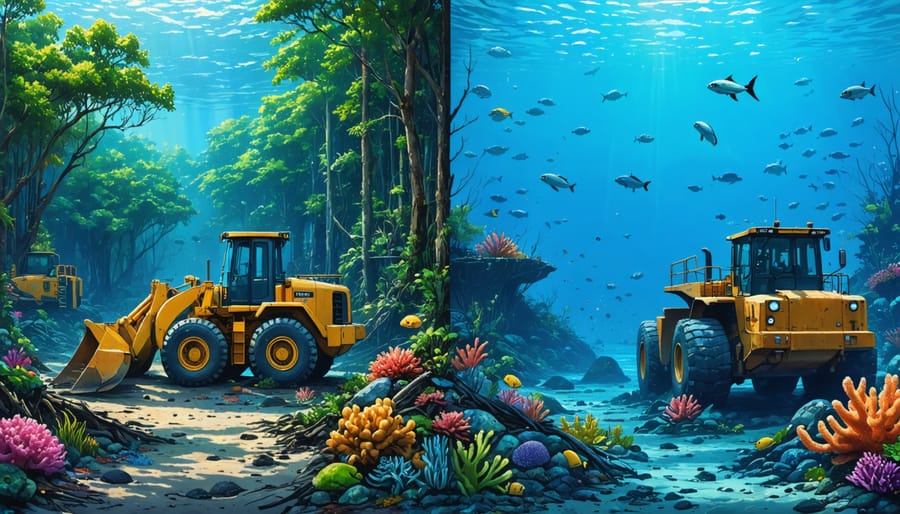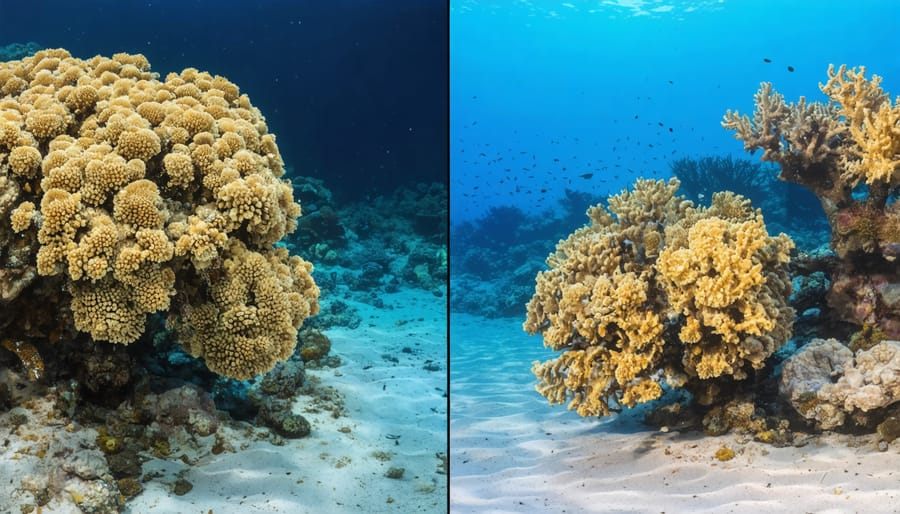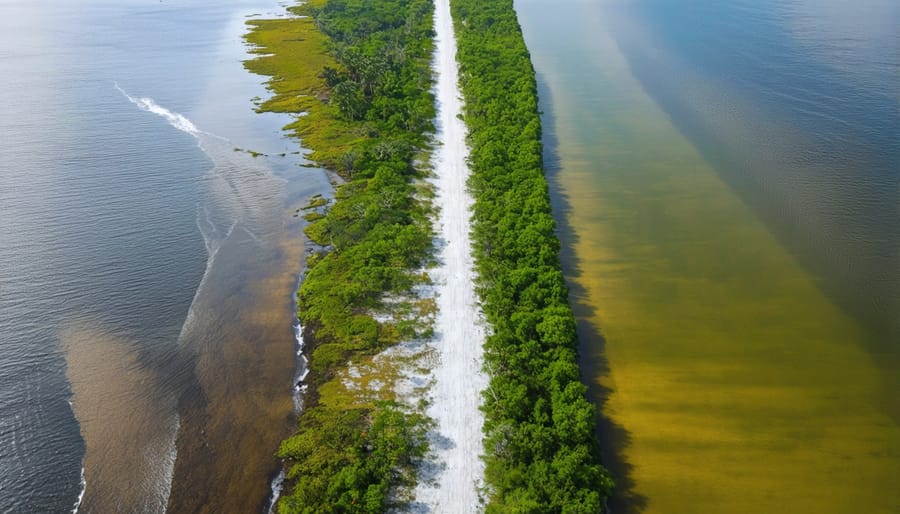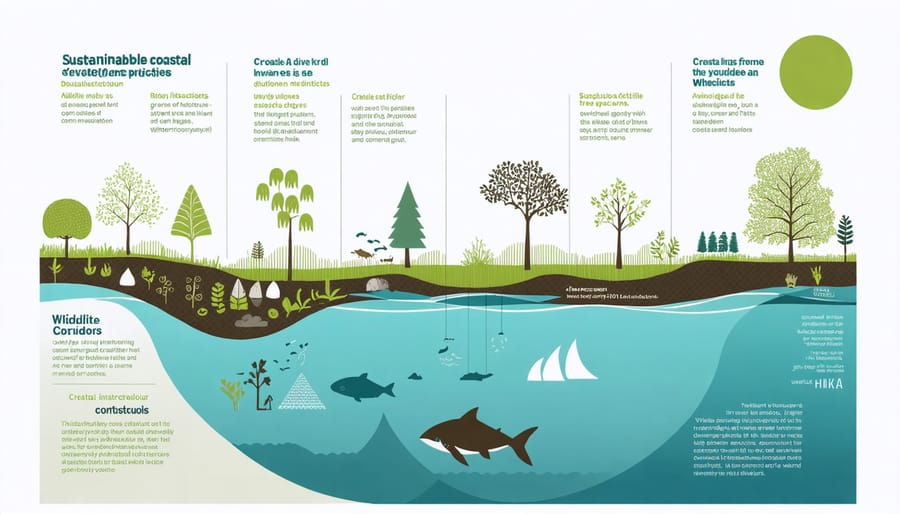
Where land meets sea, coastal marine ecosystems form Earth’s most dynamic and productive natural environments, supporting over 80% of global marine biodiversity. These intricate networks of mangroves, seagrass meadows, coral reefs, and tidal marshes serve as nature’s first line of defense against climate change, absorbing up to 50 times more carbon than tropical rainforests while protecting millions of coastal communities from rising seas and storm surges.
Yet these vital ecosystems face unprecedented threats from human activities, with coastal development and pollution driving habitat loss at alarming rates. Every year, we lose approximately 2% of our seagrass meadows and 1% of mangrove forests – critical nurseries for commercial fish species and essential barriers against coastal erosion. This loss not only threatens marine biodiversity but also jeopardizes the livelihoods of over 3 billion people who depend on marine resources for survival.
Understanding the delicate balance between coastal development and ecosystem preservation has never been more crucial. Through innovative conservation approaches, community-led restoration projects, and sustainable coastal management practices, we can protect these irreplaceable natural treasures while supporting human needs along our shores.
The Delicate Balance of Coastal Marine Ecosystems
Key Species and Their Roles
Coastal marine ecosystems host a diverse array of species that form intricate relationships vital for ecosystem health. Kelp forests serve as foundational species, creating underwater forests that provide shelter and feeding grounds for numerous marine organisms. These magnificent seaweeds also help buffer coastlines from storm impacts and sequester carbon dioxide.
Sea otters act as keystone predators, controlling sea urchin populations that would otherwise decimate kelp forests. Their presence maintains ecosystem balance and promotes biodiversity. Similarly, parrotfish play a crucial role in coral reef ecosystems by grazing on algae, preventing it from overwhelming coral colonies.
Mangrove trees are essential ecosystem engineers, with their complex root systems providing nursery habitats for juvenile fish and protecting coastlines from erosion. Filter feeders like oysters and mussels help maintain water quality by removing excess nutrients and particles, while seagrasses form underwater meadows that support dugongs, sea turtles, and countless fish species.
These key species work together in a delicate balance, each playing a vital role in maintaining coastal ecosystem health and resilience. Their preservation is crucial for sustaining marine biodiversity and supporting human communities that depend on coastal resources.
Natural Habitat Features
Marine coastal ecosystems feature diverse natural habitats that serve as the foundation for marine life. Mangrove forests stand as nature’s shoreline guardians, their complex root systems creating protective nurseries for juvenile fish while preventing coastal erosion. These remarkable trees have adapted to thrive in the challenging interface between land and sea, filtering pollutants and storing significant amounts of carbon.
Seagrass meadows form underwater prairies that provide vital feeding grounds for sea turtles and dugongs while supporting countless fish species. These productive ecosystems stabilize seafloor sediments and improve water quality through their natural filtering capabilities. A single acre of seagrass can support up to 40,000 fish and 50 million small invertebrates.
Coral reefs, often called the rainforests of the sea, create intricate three-dimensional structures that house approximately 25% of all marine species. These living architects build calcium carbonate frameworks that provide shelter, feeding grounds, and breeding sites for countless marine organisms. The symbiotic relationship between corals and zooxanthellae algae demonstrates the delicate balance that maintains these ecosystems’ health.
Together, these habitats form an interconnected network essential for coastal biodiversity and human communities alike.
Direct Impacts of Coastal Development
Habitat Destruction
Physical damage to marine coastal ecosystems has reached unprecedented levels, primarily driven by human activities and the impacts of coastal urbanization. Coastal development, including the construction of ports, marinas, and beachfront properties, often requires dredging and land reclamation that directly destroys vital habitats such as seagrass meadows, coral reefs, and mangrove forests.
Marine biologist Dr. Sarah Chen, who has spent two decades studying Southeast Asian coastal ecosystems, reports that up to 30% of mangrove forests have been cleared for aquaculture and coastal development in the past quarter-century. These areas once served as crucial nurseries for juvenile fish and natural barriers against storm surges.
Bottom trawling, a fishing method that drags heavy nets across the seafloor, causes extensive damage to benthic communities and their habitats. This practice can destroy centuries-old coral formations in minutes and disturb sediment patterns that marine species depend on for survival.
Tourism infrastructure development also contributes significantly to habitat destruction. The construction of beach resorts often leads to shoreline modification, increased sedimentation, and the removal of natural vegetation that stabilizes coastal areas.
Fortunately, conservation efforts are making progress through initiatives like artificial reef deployment and mangrove restoration projects. Local communities can participate in these efforts through volunteer programs that help monitor and protect vulnerable coastal areas.

Water Quality Changes
The quality of coastal waters faces increasing pressure from various anthropogenic sources, fundamentally altering marine ecosystems. These marine pollution impacts include elevated nutrient levels from agricultural runoff, industrial discharge, and untreated sewage, leading to harmful algal blooms and oxygen-depleted zones.
Sediment loading from coastal development and deforestation poses another significant threat. When excessive sediment enters marine waters, it can smother coral reefs, seagrass beds, and other critical habitats. The increased turbidity reduces light penetration, hampering photosynthesis in marine plants and affecting the entire food chain.
Chemical pollutants, including heavy metals, pesticides, and microplastics, accumulate in marine sediments and biomagnify through the food web. These contaminants can persist for decades, causing long-term damage to marine organisms and potentially affecting human health through seafood consumption.
Ocean acidification, driven by increasing atmospheric CO2 levels, represents a growing concern for marine ecosystems. As seawater becomes more acidic, organisms that build calcium carbonate shells or skeletons, such as corals and mollusks, face significant challenges in maintaining their structures.
The good news is that many coastal communities are implementing innovative solutions, from advanced wastewater treatment systems to green infrastructure that filters runoff naturally. These efforts, combined with stricter pollution controls and public awareness campaigns, show promising results in improving water quality and protecting marine life.
Long-term Consequences

Species Population Decline
Recent decades have witnessed alarming declines in numerous marine species populations along coastal ecosystems worldwide. Data from long-term monitoring programs indicate that many iconic species, including sea turtles, manatees, and various shark species, have experienced significant population reductions of 50-80% since the 1970s.
Coral reef fish communities have been particularly affected, with some regions reporting up to 75% decrease in population density. Key commercial fish species, such as cod and grouper, have reached critically low numbers in many coastal areas, disrupting both ecosystem balance and local fishing economies.
Marine mammals face mounting challenges, with some local populations of bottlenose dolphins showing annual decline rates of 3-5%. Similarly, several species of seabirds that depend on coastal habitats have seen their numbers plummet, with some colonies reduced by more than 60% in just two decades.
Scientists point to multiple contributing factors, including habitat destruction, overfishing, pollution, and climate change impacts. For instance, studies show that seagrass meadows, crucial nursery grounds for many species, are disappearing at a rate of 7% annually in some regions.
However, conservation efforts have shown promising results in several areas. The successful recovery of humpback whale populations and the gradual increase in some sea turtle nesting sites demonstrate that targeted protection measures, when properly implemented and supported by local communities, can effectively reverse population declines.
Ecosystem Function Disruption
The disruption of marine coastal ecosystems creates far-reaching consequences that extend beyond individual species loss. When coastal habitats are damaged or destroyed, the intricate web of ecological relationships begins to unravel, affecting everything from food web dynamics to nutrient cycling. For instance, the loss of seagrass beds not only impacts species that directly depend on them for shelter but also disrupts carbon sequestration processes and sediment stabilization.
These ecosystem disruptions often trigger cascade effects throughout the marine environment. The removal of key predator species can lead to population explosions of their prey, potentially causing devastating impacts on vegetation and other marine life. Similarly, the destruction of mangrove forests doesn’t just eliminate crucial nursery grounds for juvenile fish; it also reduces natural coastal protection against storms and diminishes the ecosystem’s capacity to filter pollutants.
Marine scientists have observed that when one component of the coastal ecosystem is compromised, the effects ripple through the entire system. For example, coral reef degradation affects not only the countless species that depend on these structures for habitat but also impacts local fish populations, which in turn affects larger predatory species and ultimately, human fishing communities.
The good news is that marine ecosystems demonstrate remarkable resilience when given the chance to recover. Through targeted conservation efforts and habitat restoration projects, many coastal areas have shown signs of regeneration, proving that ecosystem function can be restored with proper management and protection.
Solutions and Conservation Efforts
Sustainable Development Practices
The integration of sustainable coastal development practices has become increasingly crucial for preserving marine ecosystems while supporting human communities. These practices focus on minimizing environmental impact through innovative urban planning and construction methods that protect coastal habitats.
Key approaches include the implementation of living shorelines, which use natural materials and native vegetation to stabilize coastlines instead of traditional concrete seawalls. These solutions not only prevent erosion but also create valuable habitat for marine species and improve water quality through natural filtration.
Green infrastructure plays a vital role in sustainable coastal development. Permeable pavements, bioswales, and rain gardens help manage stormwater runoff, reducing pollution that reaches marine environments. These systems mimic natural water cycles and prevent harmful sediments and contaminants from entering coastal waters.
Coastal buffer zones represent another essential strategy, establishing protected areas between development and shorelines. These zones typically span 50-100 meters inland, preserving natural vegetation and providing crucial habitat for both marine and terrestrial species while protecting human infrastructure from storm surges.
Marine spatial planning has emerged as a powerful tool for balancing development needs with ecosystem protection. This approach involves careful mapping of marine resources and human activities, ensuring that development occurs in areas that minimize impact on sensitive marine habitats.
Success stories from coastal communities worldwide demonstrate that economic growth and environmental protection can coexist. For instance, eco-tourism initiatives have created sustainable revenue streams while incentivizing the preservation of pristine coastal environments.

Community Action and Involvement
Community engagement plays a vital role in protecting marine coastal ecosystems, with numerous successful initiatives demonstrating the power of collective action. Local conservation groups regularly organize beach cleanups, citizen science programs, and educational workshops that make meaningful contributions to ecosystem preservation.
Individuals can get involved in various ways, from participating in regular beach cleanup events to joining monitoring programs that track marine species populations. Many coastal communities have established volunteer networks that work alongside marine biologists to collect data on water quality, document wildlife sightings, and monitor coral reef health.
Successful community initiatives include the “Seagrass Watch” program, where volunteers help scientists monitor seagrass beds, and the “Coast Guardian” projects, which engage local residents in protecting nesting sites for marine birds and turtles. These programs not only contribute valuable data for research but also foster a sense of environmental stewardship among participants.
Educational outreach programs in schools and community centers help raise awareness about marine conservation. Students can participate in hands-on learning experiences, such as tide pool exploration and marine wildlife observation, while adults can attend workshops on sustainable fishing practices and responsible coastal development.
To get involved, interested individuals can:
– Contact local marine conservation organizations
– Join citizen science projects
– Participate in regular beach cleanup events
– Support sustainable fishing practices
– Attend educational workshops and seminars
– Share knowledge with others in the community
– Report wildlife strandings or environmental concerns
These collective efforts create a powerful network of informed citizens working together to protect our valuable marine coastal ecosystems for future generations.
Marine coastal ecosystems stand as vital guardians of our planet’s biodiversity and environmental health. Through our exploration of these complex systems, we’ve seen how they serve as nurseries for countless species, protect our shorelines, and help regulate global climate patterns. Yet these precious ecosystems face unprecedented challenges from human activities and climate change.
The good news is that we’re witnessing growing success in conservation efforts worldwide. From community-led initiatives in mangrove restoration to international partnerships protecting coral reefs, these achievements demonstrate that positive change is possible through collective action. Marine scientists and local communities are working together, combining traditional knowledge with modern conservation techniques to preserve these critical habitats.
However, the future of our coastal ecosystems depends on continued commitment and action. Each of us can contribute to their protection through simple yet meaningful steps: supporting sustainable seafood practices, reducing plastic consumption, participating in beach cleanups, or advocating for marine protected areas in our regions.
For those inspired to do more, numerous opportunities exist to get involved in citizen science projects, join local conservation groups, or support research initiatives. By understanding the value of marine coastal ecosystems and taking action to protect them, we ensure these vital natural systems continue to thrive for generations to come. The time to act is now – our oceans’ future depends on the choices we make today.
jessica
Ava Singh is an environmental writer and marine sustainability advocate with a deep commitment to protecting the world's oceans and coastal communities. With a background in environmental policy and a passion for storytelling, Ava brings complex topics to life through clear, engaging content that educates and empowers readers. At the Marine Biodiversity & Sustainability Learning Center, Ava focuses on sharing impactful stories about community engagement, policy innovations, and conservation strategies. Her writing bridges the gap between science and the public, encouraging people to take part in preserving marine biodiversity. When she’s not writing, Ava collaborates with local initiatives to promote eco-conscious living and sustainable development, ensuring her work makes a difference both on the page and in the real world.
